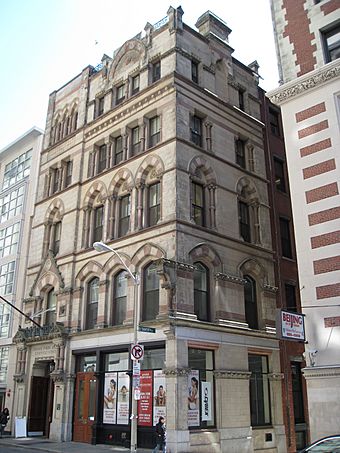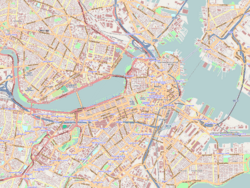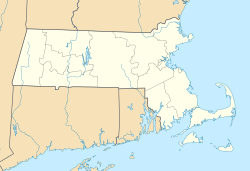Boston Young Men's Christian Union facts for kids
Quick facts for kids |
|
|
Boston Young Men's Christian Union
|
|
 |
|
| Location | Boston, Massachusetts |
|---|---|
| Built | 1875 |
| Architect | Bradlee & Winslow; Morton & Chesley |
| Architectural style | Gothic |
| MPS | Boston Theatre MRA |
| NRHP reference No. | 80000451 |
| Added to NRHP | December 9, 1980 |
The Boston Young Men's Christian Union (BYMCU) is a historic building and a special group for young people in Boston, Massachusetts. It's located at 48 Boylston Street.
Back in 1851, a group of students from Harvard University started a Christian discussion group. They did this because people from the American Unitarian Association were not allowed to join the Boston YMCA at the time. In 1852, this group officially became the Boston YMCU.
In 1873, the organization decided to build its own home. They raised a lot of money, about $270,000, and the first part of the building was finished in 1875. The building was designed by Nathaniel Jeremiah Bradlee. It was built in a style called High Victorian Gothic, which means it has a grand, old-fashioned look with pointed arches and detailed decorations. The building also had shops on the ground floor.
Over the years, more parts were added to the building, including one in 1956. The city of Boston recognized it as a Boston Landmark in 1977. Later, in 1980, it was added to the National Historic Register, which lists important places across the country.
The Boston YMCU also owned a large camp called Camp Union. It was about 600 acres in Greenfield, New Hampshire. The camp operated from 1929 to 1993. Today, it's known as the Barbara C. Harris Camp & Convention Center.
From 2003 to 2011, the building was used as the Boylston Street Athletic Club. Later, it was called the Boston Union Gym or BYMCU Athletic Club. The Boston Young Men's Christian Union proudly says it was "America's First Gym".
In 2012, the Massachusetts Commission for the Blind moved out of the building. After that, the organization started having money problems. In 2016, there were plans to change the building into 46 units of affordable housing. This project was planned with the Planning Office for Urban Affairs of the Archdiocese of Boston.
Contents
What the BYMCU Wanted to Do (1852)
In 1852, the main goal of the BYMCU was to create a welcoming place for young men in Boston. They wanted to offer a positive and uplifting environment. It was a place where young men could improve themselves and have healthy fun. They could do all this for very little or no cost. The Union also gave them chances to help others through charity work.
Who Could Join the BYMCU?
Any young man who had good character could become a member. They also needed to believe in the basic ideas of Christianity. It didn't matter what specific church or group they belonged to.
Fun and Helpful Activities
The BYMCU offered many different activities to help young men grow and learn.
Learning and Entertainment
In 1871, the Union had several committees that organized its work. These included groups for finances, lectures, classes, and entertainment. There were also committees for the library, rooms, members, and helping others.
By 1875, the BYMCU offered many classes. Young men could learn about:
- Book-keeping (how to manage money records)
- German and French languages
- Parliamentary law (rules for meetings)
- Vocal music
- Astronomy (study of stars and planets)
- Elocution (public speaking)
- Shakespeare (famous plays)
The Union also held monthly social events. Many educated women from Boston attended these gatherings. Around Christmas and New Year's, they even hosted a special festival for children from poor families.
Helping the Community
The BYMCU was very active in helping people.
- They held religious services every Sunday, except in July and August.
- They helped young men find seats in churches.
- They provided teachers for Sunday schools and missions.
- They recommended good places for young men to live.
- They helped members find jobs.
- They helped people save their money.
In 1895, the Union helped 2,318 children and 267 adults go to the countryside for short trips. They also arranged carriage rides and other outings for 8,070 people who were sick or couldn't leave their homes easily.
By 1900, the classes had become even more popular and varied. The library had grown to 15,000 books. The membership reached 5,554 people. The Union spent over $18,000 on drives, boat trips, and country visits for people in need.
See also
Images for kids





